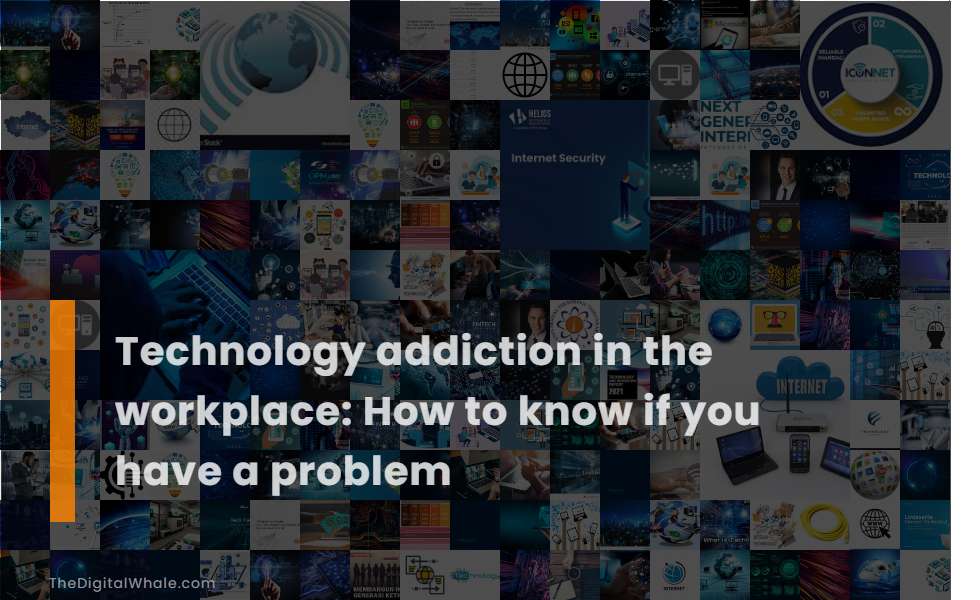Technology Addiction In the Workplace: How To Know If You Have A Problem
when is it acceptable to use technology in the workplace? What are some harmful effects of technology addiction? Let's find out more about Technology Addiction In the Workplace: How To Know If You Have A Problem.

Excessive or inappropriate use of technology, such as scrolling through social media or playing video games during work hours.
Technology addiction in the workplace manifests as excessive or inappropriate use, such as spending hours browsing social media, compulsively checking emails, or being obsessed with virtual tasks, leading to reduced productivity, heightened stress, and compromised mental health. Common signs include dealing with feelings of anxiety or restlessness when unable to use technology and multitasking with multiple devices, indicating a difficulty in focusing and a preoccupation with technology use. For more insights on addressing these issues, the Corporate Wellness Magazine article on Digital Detox provides valuable information on overcoming tech addiction in professional environments.
Feeling anxious, fidgety, or isolated when unable to use technology, leading to withdrawals.
Feeling anxious, fidgety, or isolated when unable to use technology, and experiencing withdrawals due to the lack of access to devices, are significant signs of technology addiction, indicating a strong psychological dependence on technology. This sense of anxiety and isolation can become profound, leading to withdrawal symptoms such as distress when deprived of technology use. For more insights on this topic, visit the comprehensive resource on Signs of an Addiction to Technology, which provides detailed information on the prevalence and impacts of such dependencies.
Multiscreening and multitasking with different devices, affecting focus and productivity.
Multiscreening and multitasking with different technology devices can be a sign of technology addiction, leading to difficulties in focusing on one task, which can negatively impact productivity and performance in the workplace and other environments. Engaging in multitasking and frequently switching between apps and devices increases stress, affects mood and motivation, and reduces productivity, indicating a potential technology addiction that hampers focus and efficiency at work.
Experiencing a high or feeling of gratification from technology use, leading to increased usage.
Experiencing a high or feeling of gratification from technology use, such as completing a hard level in a game or getting many likes on social media, can lead to increased usage as the individual seeks more of this easily accessible gratification. This often builds tolerance, trapping individuals in a cycle of seeking higher levels of usage. To explore more on this topic, Educare provides comprehensive insights on the Signs of an Addiction to Technology, offering valuable information to identify and manage such behaviors effectively.
Losing track of time spent using technology, resulting in neglect of work responsibilities.
Excessive technology use in the workplace can lead to diminished employee performance and well-being, as the blurring of the line between work and life results in increased cognitive load and decreased productivity. Employees often spend inordinate amounts of time on technology, neglecting other responsibilities. One key indication of an Addiction To Technology is losing track of time spent using devices. This can result in individuals becoming so engrossed in their screens that they overlook work responsibilities and fail to notice the passage of hours. Consequently, this often leads to procrastination and negatively impacts their ability to study or work effectively.
Related:
How much communication is necessary to keep everyone up to date on what's going on? What are some tips to have a thriving career in technology? Let's find out more about Tips for Thriving In A High-Tech Workplace.
Feelings of guilt and defensiveness about technology use, possibly leading to hiding or lying about the extent of use.
Feeling guilty or defensive about technology use, and possibly hiding or lying about the extent of use, are significant indicators of technology addiction, often tied to impacts on work effectiveness and social interactions. Such Signs of an Addiction to Technology highlight the challenges individuals face, where feelings of guilt and defensiveness can lead to concealing or lying about the amount of time spent on technology. This behavior is often linked to concerns from family or friends and the negative impact on work or study performance.
Prioritizing technology use over work, school, or personal obligations.
Technology addiction in the workplace can be identified by signs such as excessive or inappropriate use, where individuals prioritize technology use over work or personal obligations. This behavior often leads to procrastination, avoidance of tasks, and feelings of guilt or defensiveness about their technology habits. Understanding these patterns of technology dependency is crucial, and for more insights on Technology Addiction, valuable resources are available to explore effective solutions and coping strategies.
Withdrawal from in-person social interactions and meetings in favor of online connections.
Technology addiction in the workplace often manifests through a noticeable withdrawal from in-person social interactions and meetings, preferring online connections and behaviors such as multiscreening. Individuals may feel anxious or fidgety when they are unable to use technology, potentially neglecting work responsibilities to indulge in online activities. According to TechTarget, such addiction can lead to social isolation, as individuals set aside time with others and leisure activities for online engagements. Despite adverse consequences, such as encountering problems at work or school, the addictive behaviors often persist. Common withdrawal symptoms experienced when attempting to limit technology use include restlessness, moodiness, and irritability.
Physical symptoms such as eye strain, headaches, and disrupted sleep patterns due to excessive screen time.
Excessive screen time in the workplace can lead to physical symptoms such as eye strain, headaches, and disrupted sleep patterns. Prolonged screen exposure causes digital eye strain, poor posture leading to neck and back pain, and interferes with melatonin production, resulting in sleep disorders and other health risks. For more information on this topic, explore the Effects of Excessive Screen Time on Overall Health website. Understanding and mitigating these effects is crucial for maintaining one's health and well-being.
Neglecting responsibilities and struggling to control or reduce technology use despite repeated attempts.
Technology addiction in the workplace often manifests through the neglect of responsibilities and the inability to limit or reduce technology use, despite numerous attempts. This can lead to symptoms such as increased usage, withdrawal symptoms, and a constant preoccupation with being online. The signs of technology addiction also include spending excessive time on devices, experiencing anxiety or irritability when unable to use them, and neglecting important duties. These behaviors indicate a profound struggle to control technology use, significantly affecting one's personal, social, and professional life.
Related:
How can I turn my career goals into reality? What can I do to make my career goals a reality? Let's find out more about Making Your Career Goals A Reality with Technology.
